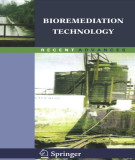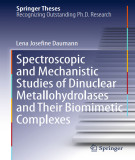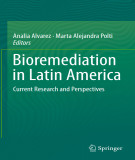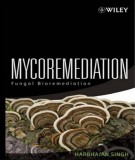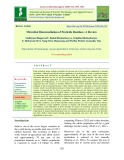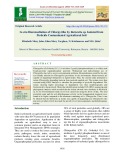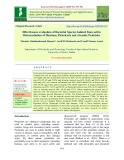
Bioremediation of pesticides
-
Ebook "Bioremediation technology: Recent advances" discusses bioremediation technology-based remediation to restore contaminated sites and protect the environment. It studies the opportunities for more efficient biological processes in molecular biology and ecology. Notable accomplishments of these studies include the cleaning up of polluted water and contaminated land. The book includes invited papers by eminent contributors who provide cost-effective bioremediation strategies to immobilize contaminants for cleanup of environment.
 391p
391p  giangdongdinh
giangdongdinh
 28-05-2024
28-05-2024
 1
1
 1
1
 Download
Download
-
Ebook "Spectroscopic and mechanistic studies of dinuclear metallohydrolases and their biomimetic complexes" has led to a better understanding of the metal ion binding and active site structural features of the enzyme GpdQ. Daumann describes how she successfully immobilized phosphoesterase and related biomimetics on solid supports for potential applications in the area of bioremediation of organophosphate pesticides.
 253p
253p  tudohanhtau1006
tudohanhtau1006
 29-03-2024
29-03-2024
 4
4
 1
1
 Download
Download
-
Ebook "Bioremediation in Latin America: Current research and perspectives" compiles an update information about the state of bioremediation in emerging Latin American countries. Some of the studied regions are sites that suffered decades of pollution by agrochemicals, heavy metals and industrial waste due to the lack of control by government regulations. Such is the case of Northern Argentina, where were illegally deposited over 30 tn of obsolete organochlorine pesticides in 1994.
 311p
311p  nhanphanguyet
nhanphanguyet
 28-01-2024
28-01-2024
 4
4
 2
2
 Download
Download
-
(BQ) Ebook Mycoremediation: Fungal bioremediation – Part 1 presents the following content: Fungal treatment of industrial wastewaters; fungal treatment of distillery and brewery wastes; fungal metabolism of petroleum hydrocarbons; fungal degradation of polychlorinated biphenyls and dioxins; fungal degradation of pesticides; fungal metabolism of phenols, chlorophenols, and pentachlorophenol.
 307p
307p  runordie7
runordie7
 30-08-2022
30-08-2022
 7
7
 2
2
 Download
Download
-
In the present investigation results showed a different mixture of bacteria with pesticides at 25 ppm Sa.bongori and S.aureus removing pesticides 64.8% for Atrazine, 74.4% for Diazinon and 75.7% for Pirimicarb , As for E.coli and S.aureus It showed on Atrazine 66.8%, Diazinon 76.3% and Pirimicarb 77.7%...
 12p
12p  kethamoi7
kethamoi7
 26-08-2020
26-08-2020
 10
10
 2
2
 Download
Download
-
Plant protection using synthetic pesticides has become one of the essential components of modern agriculture. Although need based judicious application of pesticides have made a significant impact on increasing crop productivity in agricultural sector by combating heavy losses due to pest infestation but there are lots of serious associated bottlenecks with pesticides. The major issues related to pesticide application are environmental pollution, health hazards, pest resurgence, secondary pest outbreak etc.
 11p
11p  angicungduoc6
angicungduoc6
 22-07-2020
22-07-2020
 17
17
 1
1
 Download
Download
-
Chlorpyrifos (O,O-diethyl O-3, 5, 6-trichloro-2-pyridyl phosphorothioate) is a widely used broad-spectrum organophosphate pesticide. Widespread and indiscriminate use of Chlorpyrifos has led to severe environmental problems. Bioremediation would be the only eco-friendly solution for Chlorpyrifos persistence in the environment. Many bacteria are capable of degrading Chlorpyrifos in liquid media. Thus, the current study attempted to isolate Chlorpyrifos degrading bacteria from pesticide applied soil.
 12p
12p  trinhthamhodang1212
trinhthamhodang1212
 06-04-2020
06-04-2020
 25
25
 2
2
 Download
Download
-
In the present investigation, bacterial species such as E. coli, S. aureus and S. bongori were isolated from soil by using serial dilution. Bioremediation results showed the S. aureus was highly efficient on Diazinon removal by 62%, 63.2% and 68.6%, Pirimicarb removal was 44%, 52.4% and 53.8%, and Atrazine removal was 61%, 65.6% and 70.6%. and the efficiency of E. coli removal on Diazinon was 59%, 60.8% and 63.8%; on Pirimicarb was 44%, 52.4% and 53.8%; and for Atrazine 57%, 60.8% and 64.4%. S. bongori efficiency on Diazinon was 49%, 51.2% and 55.8%; on Pirimicarb removal was 61%, 63.
 8p
8p  caygaocaolon4
caygaocaolon4
 04-04-2020
04-04-2020
 21
21
 2
2
 Download
Download
CHỦ ĐỀ BẠN MUỐN TÌM








